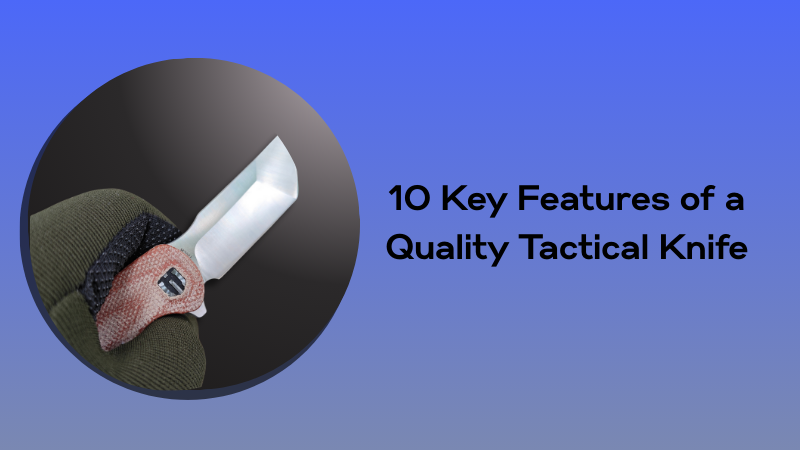
10 Key Features of a Quality Tactical Knife
 Tactical knives serve a
variety of functions, making them a valuable tool in any collection. Designed
for defense, they provide protection in high-risk situations, particularly
during outdoor activities like camping and hunting. In addition to defense,
tactical knives can be used for cutting, fishing, and other practical tasks.
When investing in a tactical knife, it's essential to consider key features
that ensure the tool meets your specific needs. Here are 10 important aspects
to keep in mind when choosing the best tactical knife.
Tactical knives serve a
variety of functions, making them a valuable tool in any collection. Designed
for defense, they provide protection in high-risk situations, particularly
during outdoor activities like camping and hunting. In addition to defense,
tactical knives can be used for cutting, fishing, and other practical tasks.
When investing in a tactical knife, it's essential to consider key features
that ensure the tool meets your specific needs. Here are 10 important aspects
to keep in mind when choosing the best tactical knife.
Design Matters
The
design of a tactical knife plays a critical role in its functionality. From
blade shape to handle ergonomics, every element contributes to how well the
knife performs in various scenarios. When choosing a Shieldon knife, for
example, you’ll find a range of blade styles that cater to different uses. The
design should align with your intended tasks, whether for self-defense, outdoor
survival, or general utility.
Fixed vs. Folding Blade Knife
Tactical
knives come in both fixed and folding blade options, each offering distinct
benefits. Fixed-blade knives are ideal for heavy-duty tasks such as chopping,
prying, or hammering. In contrast, a folding knife, like a Shieldon pocket
knife, provides portability and convenience, especially for EDC (Everyday
Carry) use. A folding knife can easily slip into your pocket, offering quick
access while maintaining a compact size.
Size Considerations
The
size of your tactical knife will affect both its usability and portability.
Smaller knives, such as a compact EDC knife, are easier to carry and can fit in
your pocket for everyday use. On the other hand, larger knives provide more
control for heavy tasks but may require a sheath or carry bag. Finding the
right balance between size and function is key to selecting the perfect
tactical knife.
Single Edged Blade
For
versatility and safety, a single-edged blade is the preferred choice for
tactical knives. Dual-edged blades can make it harder to perform certain tasks,
and the risk of cutting yourself is higher. A Shieldon tactical knife
with a single sharp edge on one side provides better control and efficiency for
various applications, from cutting rope to self-defense.
Handle Design and Comfort
A
comfortable, ergonomic handle is vital for effective use of a tactical knife.
Look for a handle that offers a solid grip and is designed to fit your hand
comfortably. Materials like G10, Micarta, or stainless steel ensure durability
and provide a non-slip grip, even in wet conditions. A well-designed handle
reduces hand fatigue and enhances performance during intense or prolonged use.
Handle Material
The
handle material affects the overall feel and performance of your knife. G10 and
Micarta are popular choices for their strength and comfort. Stainless steel
handles, while sturdy, offer a firmer grip and resistance to the elements. The
handle material should not only feel comfortable but also be durable enough to
withstand the harshest conditions.
Straight vs. Serrated Edges
Straight-edge
blades are easier to sharpen and maintain than serrated blades, making them a
better option for tactical knives. A straight edge offers superior control,
making it an excellent choice for detailed tasks. If you’re investing in a
Shieldon folding knife or an EDC knife, a straight-edge blade ensures sharpness
and precision, especially for cutting tasks.
Blade Material
The
material of the blade is crucial for its strength and durability. Stainless
steel is corrosion-resistant, making it ideal for everyday tasks and outdoor
conditions. Carbon steel blades, while requiring more maintenance, hold an edge
longer and are often preferred for tactical and survival knives. When choosing
your knife, think about which material will best meet your needs, whether for
general use or heavy-duty tasks.
Opening Mechanism
For
folding tactical knives, the opening mechanism is a key feature. Some knives
have a traditional nail nick or thumb stud, while others feature assisted
opening systems with buttons or switches. An efficient opening mechanism
ensures quick access when the knife is needed in emergencies, but it's
important to choose a design that includes a reliable locking mechanism to
prevent accidental openings.
Locking Mechanism
The
locking mechanism on a folding knife is essential for safety. Common systems
like liner locks and lockbacks ensure that the blade remains securely in place
during use. For an EDC
knife, a dependable locking system is crucial to prevent the blade from
folding unexpectedly during tasks. Always opt for a knife that provides a solid
and secure lock, ensuring that the blade remains stable when in use.
Conclusion
Tactical
knives, including the versatile Shieldon knives, offer a combination of
durability, performance, and portability. Whether you're using it for
self-defense, outdoor adventures, or everyday tasks, understanding the key
features to look for will help you choose the best tactical knife for your
needs. The right design, blade material, handle comfort, and locking mechanisms
ensure that your knife performs at its best in any situation. Explore a variety
of tactical knife options, including pocket knives, folding knives, and martial
arts knives, to find the perfect tool for your lifestyle.


